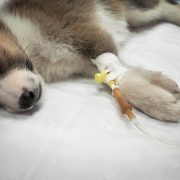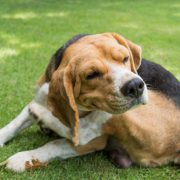Complication rates associated with nasoesophageal versus nasogastric feeding tube placement in dogs and cats: a randomised controlled trial
Complication rates associated with nasoesophageal versus nasogastric feeding tube placement in dogs and cats: a randomised controlled trial

Open access
In our edition of: Aug 2024
In our categories of: small animals
our summary:
Camacho, F. and Humm, K. (2024) Complication rates associated with nasoesophageal versus nasogastric feeding tube placement in dogs and cats: a randomised controlled trial. Journal of Small Animal Practice, 65 (7), pp. 417-423.
The aim of this randomised controlled trial was to determine the rate of accidental placement of nasoenteric (NE) tubes into the respiratory tract, to compare the methods of checking correct tube placement and to determine the complication rate between nasoesophageal (NO) and nasogastric (NG) tubes.
Dogs and cats requiring an NE tube during hospitalisation at a UK veterinary referral hospital, were enrolled in the study and randomised to either the NG or NO group. The technique of NE tube placement and tube fixing was determined by the attending veterinary surgeon. Once the tube was in place the accuracy of the placement was evaluated using assessment for negative pressure, capnography, measurement of the pH of any fluid aspirated, assessment for a cough response following administration of sterile water, assessment for audible bubbling at the end of the NE tube and ultrasound assessment of the oesophagus and stomach. Finally, a single right lateral thoracic radiograph was performed. Complications during tube placement were recorded.
Ninety-seven animals (82 dogs and 15 cats) were included in the analysis, 48 animals (43 dogs and 5 cats) in the NG group and 49 animals (39 dogs and 10 cats) in the NO group. There were 143 attempts to place the NE tubes, in 32 cases more than one attempt was required. The NE tube was misplaced in three cases (all dogs), no adverse consequences from tube misplacement was noted in any of the three cases.
None of the techniques for checking tube placement completely agreed with radiography but 86.2% of cases assessed using presence of negative pressure at the thoracic inlet and 90.47% of cases using capnography were concordant with the radiograph results.
Complications were reported in 25 animals during tube placement. The complication rate for all NE tubes during their use was 51% (49/96), the most commonly reported complications were sneezing, regurgitation and attempts at self-removal. No significant difference was reported between the nasoesophageal and nasogastric groups in either new-onset regurgitation/vomiting rate or complications while the tube was in situ.
Limitations of the study are the low number of reported misplacements of NE tubes which meant it was not possible to assess the accuracy of the tests for recognising misplacement, capnography was not always available to the clinician which resulted in a low number of animals tested for it, and it was not possible to assess differences between dogs and cats due to the small number of cats. The placement of tubes and the assessments were carried out by multiple people which may have led to variation in testing method and recording. Data for complications for the two groups was not reported separately.
This study provides evidence that the rate of misplacement of nasoenteric tubes is low and that a combination of other tests including assessing for negative pressure and capnography can be used to ensure correct tube placement if thoracic radiography is not available. Choice of placement of either a nasoesophageal or nasogastric tube should be guided by clinician preference, clients should be informed about possible complications during placement and while the nasoenteric tube is in situ.
The following may also be of interest:
inFOCUS: Comparison of 4 point-of-care techniques to detect correct positioning of nasogastric tubes in dogs (2020–2021) [RCVS Knowledge] [online] Available from: https://infocus.rcvsknowledge.org/comparison-of-4-point-of-care-techniques-to-detect-correct-positioning-of-nasogastric-tubes-in-dogs-2020-2021/ [Accessed 19 August 2024]
inFOCUS: How to place commonly used feeding tubes in dogs and cats [RCVS Knowledge] [online] Available from: https://infocus.rcvsknowledge.org/how-to-place-commonly-used-feeding-tubes-in-dogs-and-cats/ [Accessed 19 August 2024]
inFOCUS: 2022 ISFM consensus guidelines on management of the inappetent hospitalised cat [RCVS Knowledge] [online] Available from: https://infocus.rcvsknowledge.org/2022-isfm-consensus-guidelines-on-management-of-the-inappetent-hospitalised-cat/ [Accessed 19 August 2024]
Claiming CPD for reading inFOCUS articles
Reading and reflecting on articles can count towards your CPD, and we have a template to help you with the process.
Image copyright attribute: SUJITRA+CHAOWDEE / Shutterstock








Leave a Reply
Want to join the discussion?Feel free to contribute!